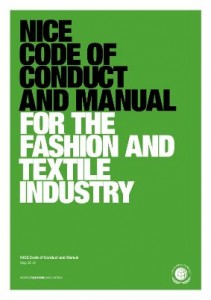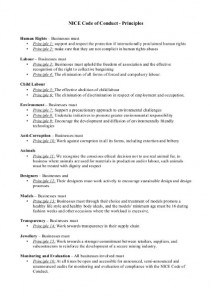 NICE Code of Conduct and Manual for the Fashion and Textile Industry.
NICE Code of Conduct and Manual for the Fashion and Textile Industry.
By: Nordic Fashion Association
Launched at the occasion of the 2012 Copenhagen Fashion Summit by the Nordic Fashion Association (NFA), this code of conduct and manual is described by the NFA as follows:
The NICE manual is a comprehensive guide for the Textile Industry, which is meant to assist you in upholding the 16 principles that constitute the Code of Conduct. (Source)
The NICE Code of Conduct and Manual strives for alignment with international standards and universal principles. For this reason, the Code and Manual have taken their inspiration from the UN Global Compact's ten principles (www.unglobalcompact.org), but have sought to provide additional specificity from a sectoral perspective. Other sector specific content has thus been included with a view to promoting higher levels of sustainability performance on a wide range of topics relevant for the fashion and textile industry.
This, and the pre- and post Fashion Summit ado in the media and social networks is reason enough to take the time and look at the this Code of Conduct in more depth, and evaluate its thoroughness and practicality for the brands and manufacturers in the textile supply chain.
The questions we would like specifically to look at are:

- How essential are the principles outlined?
- How novel are they? What are they based on?
- How valuable an addition is this code to a landscaped already littered with Codes of Conducts, Practises and Standards?
- How well is it researched?
- How useful in practise is this Code of Conduct and, specifically, the Manual for brands, manufacturers and all those working in the textile supply chain?
- What is the main strength of this Code of Conduct and Manual?
And these are our answers.
How essential are the principles outlined?
The principles are what is probably considered the ‘smallest common denominator’ of all different type of standards currently available.
They add to the baseline though in 2 aspects: First, add animal rights are added to the list of principles, something commendable, but very rarely, if at all, found in any of the other Codes of Conducts; second, the issue of underaged models and a ‘healthy’ image reflected by models into the mainstream is addressed.
In these 2 points the NICE Code of Conduct strives beyond what is normally seen in any fashion related code of conduct.
How novel are they? What are they based on?
The principles, not even the 2 additional ones mentioned above, are not novel in anyway. First of all, they base them selves on previous work of the Global Compact as well as the International Labour Organisation (ILO). The principles thereby are just formulated in a way that make it apparent that they refer to the fashion industry.
As a consequence, if any one fashion brand or manufacturer was already confronted with the demands set out by the Global Compact and the ILO (and it can be safely assumed that as far as this latter is concerned, no relevant manufacturer, and certainly not a single Western brand, will NOT have at least heard of them) the principle are all yesterday’s news.
How well is it researched?
Overall, the document is well researched, although the resources used as a base seem to be essentially limited to previous work by primarily the Global Compact (and hence the UN), the International Labour Organisation, the OECD, ISO, and ‘general purpose’ (as in: not directly related to any of the efforts invested in the last decade in relation to the fashion industry at its supply chain) NGOs such as Amnesty International.
There is a 2 page reference list at the back of the document which lists 27 different organisations, from Amnesty International to the World Bank. The list misses out though on organisations such as Labour Behind The Label, the Clean Clothes Campaign, the Fair Wear Foundation, Made-By, the Fair Wage network, WWF etc., all of which have significantly contributed to the progress made in the last few years.
How useful in practise is this Code of Conduct and, specifically, the Manual for brands, manufacturers and all those working in the textile supply chain? Is the Manual practical enough to be immediately useful?
The Manual section of each principle thoroughly lists all the relevant aspects that need to be looked into. Taking the example of Health & Safety, this means there is a light-eight audit check-list available for emergency exists, fire drills etc.
However – all that is no different than what is available from any ‘state-of-the-art’ practise Health & Safety check-list that can be downloaded from the internet. The Manual falls short in pointing out how to implement such standards in practise; or in addressing the pitfalls that can occur, how to identify issues and how to address them most effectively. Rather than lists, case studies would probably fill in the missing details how to go about in ‘real life’ in addressing these issues on site at supplying factories.
In short, while the Manual is well meant, and certainly from an academic point of view complete and suitable for management training or similar, it is very little practical, and misses out on the most important of all things: How to go about in practise in making sure that all these requirements are actually and physically implemented in the facilities of a supplier.
What is the main strength of this Code of Conduct and Manual?
No doubt, the principle strength of this Code of Conduct and Manual is that it summarises in just about 100 pages – including some full-page photographs – the very basic of responsible business practise in the fashion industry. It indeed summarises the most important aspects to be aware of – from materials, to labour rights and environmental impact – in a format suitable for in-house awareness raising in Western brands.
If a series of practical ‘Harvard business school’ style case studies were to be added for each of the principles at the included check lists, the document would fulfil its claim of a Manual effectively, but for now it still falls short of this.
How valuable an addition is this code to a landscape already littered with Codes of Conducts, Practises and Standards?
This is a question that is difficult to answer.
On the one hand, the ado with which this document has been launched, and the subsequent public response, has been considerable. The apparent lack of either compliance or good business practise in the fashion industry was brought to the surface – and that alone is a non-negligible feat.
However, the principles laid out in this document are so basic, and have been promoted previously over and again by a vast range of organisations, that it begs the question of the rationale behind writing up yet another Code of Conduct, and spending hundred thousands of Euros on a project as this.
Finally, the lack of fleshed out practical examples in the Manual is a lost opportunity at this time, and could have made a massive difference to other initiative and impacted deeply the best-practise baseline by spreading such knowledge.
We hope that given the Nordic Fashion Association’s stated interest in this Code and the project around it, such a collection of case studies illustrating best practise and how to live up to it, will become available in the course of the next year or so.

